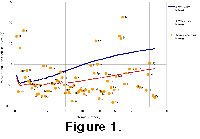THE TECHNIQUES OF CT AND NT SCANNING
X-ray Computed Tomography
The technique of CT works with X-rays interacting mainly with the electron shell of atoms. X-ray attenuation coefficients increase steadily with atomic number Z (Hubbell 1999). Computer tomographic images display differences in density and material Z composition within an object (Van
Geet et al. 2000). For a medical CT scan, the object is placed on a table with an X-ray tube (the "gantry") that rotates around the object's length axis sending an X-ray fan of 0.5 to 40 mm width. The X-ray beam passes through the object along multiple paths and is recorded on the opposite side by detectors, measuring the attenuation of its energy. CT slice images are calculated by using mathematical formulas and algorithms (Kak and Slaney 1988). Recent technology enables decreasing of the slice thickness to less than 1 mm by simultaneous acquisition of multiple slices during one rotation (multi-slice or multi-detector – CT). The option of thin slice imaging is the basis for high resolution imaging with near-to isotropic resolution in all axes. Secondary reconstruction with a 3-D display is helpful for scientific and medical purposes.
The technique of CT was introduced initially as a medical diagnostic tool and found variable applications in vertebrate palaeontology (e.g.,
Britt 1993;
Conroy and Vannier 1984;
Rowe et al. 1999). The development of high-resolution industrial-grade CT scanners additionally improved the available image resolution for the objects and provided a technique for the investigation of very small vertebrate remains (Rowe et al. 1999). Exhaustive descriptions of the technique of medical and technical X-ray computed tomography and its application to palaeontological and geological questions are given in
Carlson (1993) and
Ketcham and Carlson (2001).
Neutron Tomography
Neutron radiography (Domanus 1992) and tomography has been available since 1997 at the
Neutron Transmission Radiography Station (NEUTRA) of the Paul-Scherrer-Institute (PSI) in Villigen/Switzerland. Like CT the technique is based on the application of the universal law of attenuation of radiation passing through matter. Neutrons carry no electrical charge and interact mainly with atomic nuclei via very short-range forces. Contrary to X-rays, neutrons interact significantly with some light materials (e.g., hydrogenous substances, boron or lithium) and penetrate heavy materials with minimal attenuation.
 Therefore neutron radiography and tomography is a technique complementary to X-ray radiography and tomography and is particularly sensitive to samples where small amounts of hydrogenous materials occur with weakly interacting materials. The latter yields images with high contrast (Figure 1,
Lehmann et al. 1996,
1999).
Therefore neutron radiography and tomography is a technique complementary to X-ray radiography and tomography and is particularly sensitive to samples where small amounts of hydrogenous materials occur with weakly interacting materials. The latter yields images with high contrast (Figure 1,
Lehmann et al. 1996,
1999).
In the PSI, the neutrons are generated at the
"Swiss Spallation Neutron Source" SINQ by using a particle accelerator to direct a 590 MeV proton beam at a target of heavy metal (lead). The neutrons are then slowed down to thermal energy (~ 25 meV) in a moderator tank (filled with heavy water D2O) and extracted by a flight tube forming a collimator, which bundles neutron rays to an almost parallel beam of approximately 35 cm diameter. The beam is transmitted through the object and recorded by a plane position sensitive detector (Lehmann et al. 1996,
1999).
For tomographic images, the object is placed on a rotating table and turned in small angular steps for 180° while a Peltier-cooled CCD-camera system takes several projections. From the single projections, slices perpendicular to the rotation axis are reconstructed by a tomographic reconstruction algorithm using "filtered backprojection." The slices are then collected in an image stack that can be visualized, edited and exported into different file formats using a 3-D rendering software.

 Therefore neutron radiography and tomography is a technique complementary to X-ray radiography and tomography and is particularly sensitive to samples where small amounts of hydrogenous materials occur with weakly interacting materials. The latter yields images with high contrast (Figure 1,
Lehmann et al. 1996,
1999).
Therefore neutron radiography and tomography is a technique complementary to X-ray radiography and tomography and is particularly sensitive to samples where small amounts of hydrogenous materials occur with weakly interacting materials. The latter yields images with high contrast (Figure 1,
Lehmann et al. 1996,
1999).